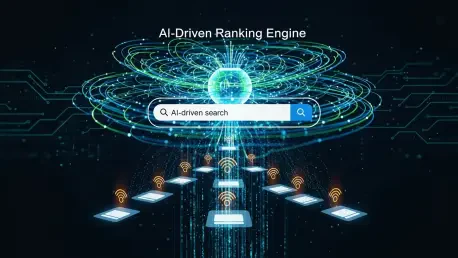Introduction to AI-Driven Information Ranking
The realm of information ranking and retrieval stands at a critical juncture, with artificial intelligence (AI) driving unprecedented advancements in how vast datasets are processed and prioritized. Search engines and large language models (LLMs) rely heavily on AI to sift through billions of data points, delivering results that align with user intent in mere milliseconds. This capability has become indispensable in an era where digital information doubles every few years, placing immense pressure on systems to perform efficiently.
Key players like Google DeepMind are at the forefront of this transformation, leveraging cutting-edge technologies such as generative AI to push boundaries. The demand for faster, more accurate processing has never been higher, as businesses and consumers alike expect seamless access to relevant content. Efficiency in handling massive data volumes is no longer just a competitive edge; it is a fundamental requirement for staying relevant in the tech landscape.
This report delves into a groundbreaking development by Google DeepMind known as BlockRank, a methodology designed to revolutionize ranking efficiency in LLMs. By addressing core challenges in computational speed and scalability, this innovation signals a potential shift in how AI systems manage information retrieval, setting the stage for a deeper exploration of its impact and implications.
Understanding BlockRank: A Breakthrough in Ranking Efficiency
Core Innovation of BlockRank
BlockRank emerges as a transformative approach in the field of AI-driven ranking, detailed in a research paper titled “Scalable In-Context Ranking with Generative Models.” At its heart, this methodology reimagines the attention mechanism within LLMs, a component traditionally responsible for evaluating relationships between words and documents. By restructuring how interactions occur, BlockRank significantly reduces the computational burden that often hampers performance.
Unlike conventional models where every document interacts with all others, leading to exponential processing costs, BlockRank limits each document to focus solely on itself and shared instructions. Meanwhile, the query retains the ability to compare across all documents, ensuring relevance is not compromised. This shift changes the attention cost from quadratic to linear, paving the way for faster and more resource-efficient operations.
The implications of this design are profound, as it allows systems to handle larger datasets without the typical slowdowns associated with scaling. This innovation addresses a long-standing bottleneck in AI ranking, offering a practical solution that could redefine operational standards across various applications, from search engines to conversational AI tools.
Performance Metrics and Benchmark Results
Experimental results underscore BlockRank’s potential, with tests conducted using the Mistral-7B model revealing remarkable improvements in speed. When ranking 100 documents, BlockRank operates 4.7 times faster than standard fine-tuned models, a leap that highlights its efficiency. Even more impressive is its scalability, managing to process 500 documents—equivalent to roughly 100,000 tokens—in approximately one second.
In terms of accuracy, BlockRank holds its own against established listwise rankers such as RankZephyr and FIRST. Across benchmarks like MSMARCO, Natural Questions (NQ), and BEIR, it either matches or surpasses competitors, demonstrating that speed does not come at the expense of quality. These results suggest a strong case for adoption in real-world scenarios where both precision and rapid response are critical.
The data points to BlockRank’s viability as a scalable solution, capable of meeting the demands of modern AI applications. As systems continue to grapple with ever-growing data inputs, such performance metrics indicate that this methodology could become a cornerstone for future developments in ranking technology.
Challenges in Scaling AI Ranking Systems
Traditional In-Context Ranking (ICR) faces significant hurdles, primarily due to its high computational expense. The attention mechanism, while effective in understanding context, compares every element to every other, resulting in processing times that grow exponentially with input size. This inefficiency poses a major barrier to scaling, especially as the volume of data requiring analysis continues to surge.
Addressing these challenges requires innovative approaches like BlockRank, which reconfigures computational priorities to achieve linear cost growth. Other strategies, such as optimized hardware or alternative model architectures, are also under exploration, though they often involve trade-offs between speed and depth of analysis. Finding a balance remains a central concern for developers aiming to deploy AI ranking systems at scale.
Beyond technical constraints, there is also the issue of maintaining user satisfaction amidst these optimizations. Ensuring that faster processing does not dilute the relevance of results is paramount, as end-users expect both immediacy and accuracy. Solutions like BlockRank offer a promising path forward, but ongoing refinement and testing are essential to meet diverse operational needs.
Regulatory and Ethical Considerations in AI Search Technology
The rapid evolution of AI search technologies operates within a complex regulatory landscape, where data privacy laws and ethical standards play a pivotal role. Governments worldwide are tightening frameworks to protect user information, mandating strict compliance from tech giants deploying ranking and retrieval systems. These regulations aim to safeguard personal data while ensuring that AI outputs remain unbiased and transparent.
Ethical considerations extend to how information is prioritized and presented to users. There is a growing emphasis on aligning results with genuine user intent rather than manipulative or commercial interests. Developers must navigate these expectations, ensuring that ranking algorithms do not inadvertently perpetuate harm or misinformation, a concern that has gained prominence in public discourse.
Transparency in model development is another critical factor, as stakeholders demand clarity on how decisions are made within AI systems. Adhering to these principles not only fosters trust but also mitigates legal risks, positioning companies to operate responsibly. As innovations like BlockRank emerge, integrating regulatory and ethical compliance into their design will be crucial for sustainable adoption.
Future Implications of BlockRank in Search Technology
BlockRank holds the potential to reshape AI-driven retrieval systems, influencing major platforms such as Google Search or Gemini. By prioritizing user intent over traditional keyword matching, this methodology could lead to more intuitive and context-aware results. Such a shift would likely enhance user experiences, aligning content more closely with underlying search purposes rather than surface-level terms.
Looking at broader trends, generative AI continues to drive rapid advancements in search technology, with increasing data volumes necessitating smarter processing solutions. Emerging innovations, including hybrid models and adaptive learning techniques, are set to further refine how information is accessed and ranked. BlockRank fits squarely within this trajectory, offering a glimpse into how efficiency and relevance can coexist.
The impact on user experience cannot be overstated, as faster and more accurate systems could redefine expectations for digital interactions. As data growth shows no signs of slowing—projected to expand significantly from this year to 2027—tools like BlockRank may become integral to managing complexity. Their adoption could signal a new era where AI not only keeps pace with demand but also elevates the quality of information delivery.
Conclusion
Reflecting on the insights gathered, BlockRank represents a significant leap forward in addressing the inefficiencies that have plagued traditional AI ranking systems. Its ability to slash processing times while upholding accuracy on rigorous benchmarks marks a turning point for large language models in information retrieval. The methodology showcases how innovative restructuring of computational mechanisms can yield tangible benefits at scale.
Moving forward, stakeholders need to prioritize the integration of such technologies into existing frameworks, ensuring that speed enhancements do not compromise ethical standards or user trust. Investment in further research to refine BlockRank’s applicability across diverse platforms is essential, as is collaboration with regulatory bodies to align with data privacy mandates. These steps promise to solidify its role in shaping a more responsive digital ecosystem.
Ultimately, the journey ahead demands a proactive approach to balancing technological advancement with societal responsibility. By fostering dialogue among developers, policymakers, and users, the industry can harness BlockRank’s potential to not only streamline operations but also elevate the relevance and integrity of search outcomes. This focus on holistic progress offers a blueprint for navigating the evolving landscape of AI-driven information ranking.









